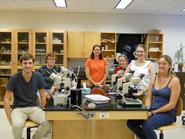
Parasitic species can help control their hosts’ populations and add to an ecosystem’s biodiversity. This summer Kristin Forgrave ’12, Christopher Kline ’12, James Liebow ’13, Jaclyn Specht ’12, and Abby Koppa ’12 worked with Visiting Assistant Professor of Biology Ashleigh Smythe on a project to explore parasitic worms in natural habitats. The group worked on three separate projects that dealt with different worm species and hosts.
Liebow and Kline conducted a study on the genetic diversity and ecology of muskrat trematodes, parasitic flatworms that use muskrats as a host. Only adult trematodes infect muskrats, and juvenile worms use various snail species as hosts. Because juvenile worms are indistinguishable, Liebow and Kline used DNA to determine which trematodes use which snails in their early stages of life. Liebow and Kline collected snails from local muskrat habitats such as the pond on the Hamilton golf course and other sites in Oneida County. The team uses gene sequences of mitochondrial and ribosomal DNA to distinguish different worm species from one another. These sequences can be compared to sequences obtained from adult trematodes collected by previous students.
Forgrave, Specht and Koppa researched entomopathogenic nematodes, which use insect larvae as their hosts. They collected soil samples from sites on campus and using moth larvae to attract nematodes. Their attempts appeared successful, as indicated by a color change in the larvae. These nematodes were unique from the other worms in this study because they must kill the insect larvae in order to survive and reproduce, while the other parasites that Professor Smythe’s students worked with are relatively harmless to their host. Entomopathogenic nematodes are currently being used for pest control in agriculture, as the worms kill insects before they harm crops. The group hoped to find more diversity among insect nematodes and characterize the species that they find.
Forgrave, Specht and Koppa also worked on a project to characterize a potentially new nematode species found in crayfish. They found this nematode unexpectedly while dissecting crayfish in search of trematodes. They used DNA sequencing and microscopy to identify it. There are few prior reports of nematodes infecting crayfish, so it is possible that they have discovered a new species.
The students, who are all biology majors, became interested in these projects after taking either Invertebrate Biology or Parasitology, both courses offered by Smythe. They enjoyed their field work and the opportunity to spend time outdoors, as well as the process of learning more about these diverse and ecologically significant worm species.
These projects combine traditional lab and field techniques with modern molecular methods to explore the local ecosystem and its biodiversity. Their work promises to reveal more about Hamilton’s environment and, more generally, the study of parasitic worms.
Kristin Forgrave is a graduate of Lake Washington High School (Washington); Christopher Kline graduated from Fonda-Fultonville High School (N.Y.); Abigale Koppa is a graduate of Southern Regional High School in Manahawkin, N.J.; James Liebow graduated from Spencerport High School (N.Y.); and Jaclyn Specht is a graduate of North Andover High School (Mass.).
Posted August 25, 2011
